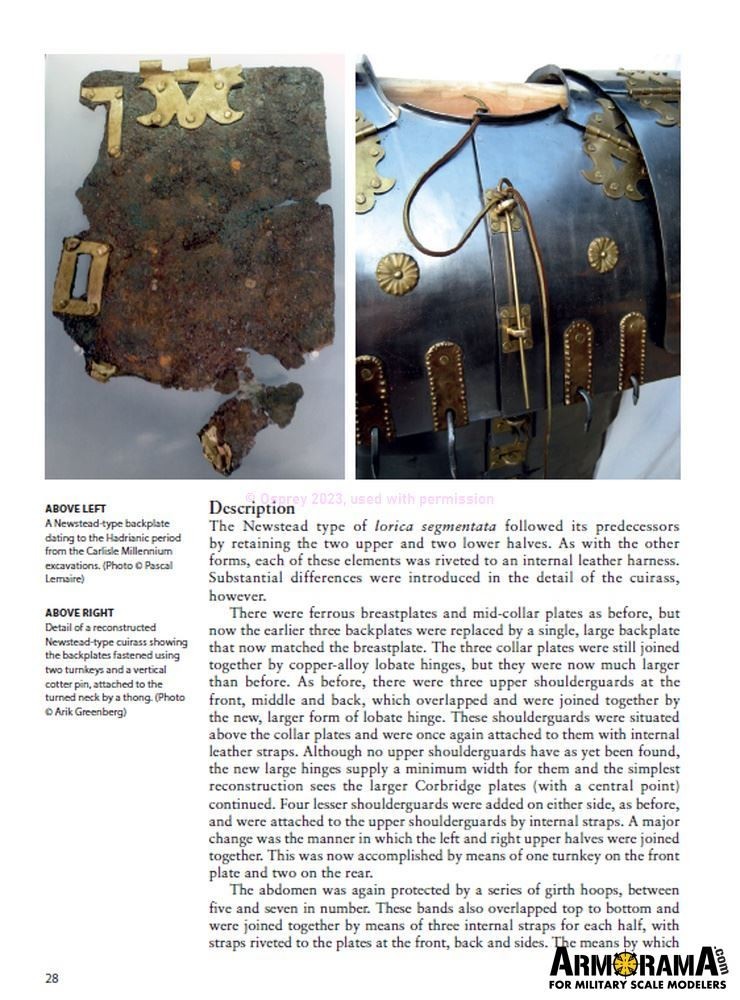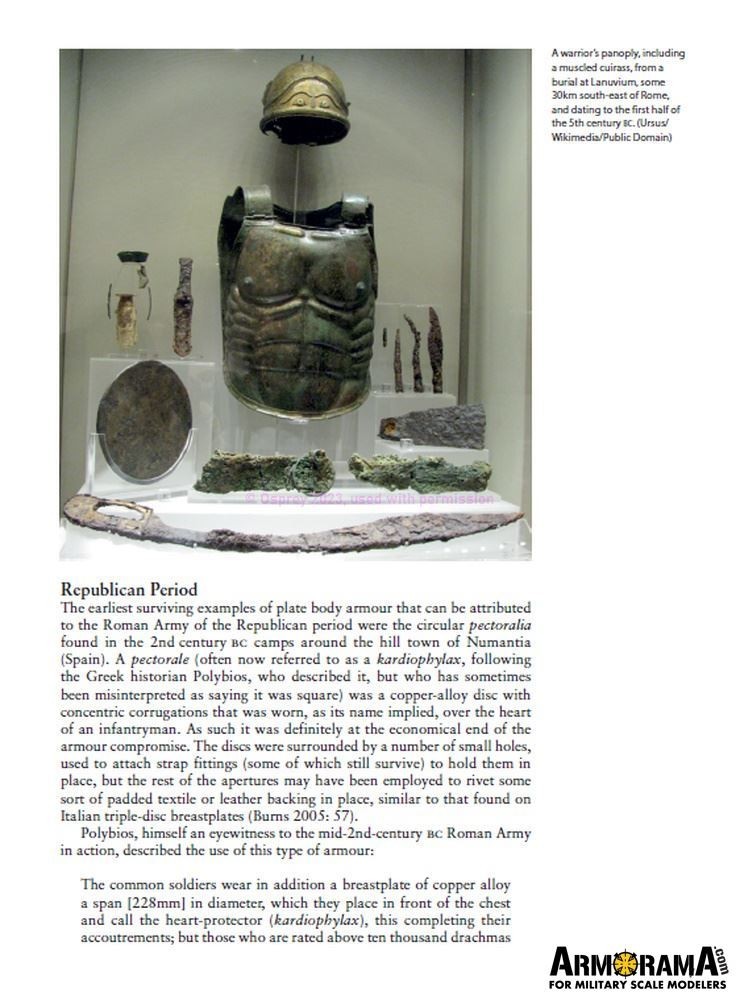
Introduction
Roman Plate Armour is a recent release from Osprey Publishing, authored by M.C. Bishop and illustrated by Giuseppe Rava. It is the 247th title of the series Elite. Catalogued with ISBN 9781472851871 and the Osprey short code ELI 247, this monograph examines one of the iconic body armor systems of antiquity, Roman ‘lorica’ protected soldiers as they won – and held - much of the Roman Empire. This 64-page book is available in softcover, PDF and ePUB formats.
As Osprey describes the book;
The spectacular find of six halves of cuirasses in a chest at Corbridge in 1964 has now been matched by the rare discovery of a complete set of this armour at Kalkriese. The Corbridge find provided the context to interpret and reconstruct earlier finds. There is now years of experience gleaned from reenactors over the practical strengths and weaknesses of this form of armour. At the same time, scientific analysis has provided insights into the technology behind this revolutionary form of armour so characteristic of the Roman Army. Featuring specially commissioned artwork and drawing upon the latest findings, this study lifts the veil on the formidable plate armour used by the legionaries of Imperial Rome.
In my Roman civilization classes we unfortunately did not study cool stuff like armor and weapons, thus my knowledge of Roman armor originates from Hollywood. Fortunately, Mr. Bishop has taken the time to share his research and knowledge with us through his books. Let’s gird ourselves from the fiction for triumph of facts.
Content
Roman Plate Armour is presented through 33 chapters and subsections, plus front and back material, in 64 pages:
INTRODUCTION
Regal Period*Republican Period*Terminology
KALKRIESE-TYPE LORICA SEGMENTATA
History*Description*Variants
CORBRIDGE-TYPE LORICA SEGMENTATA
History*Description*Variants
NEWSTEAD-TYPE LORICA SEGMENTATA
History*Description*Variants
OTHER FORMS OF PLATE ARMOUR
Hybrid forms*Armguards*Muscled cuirasses*Greaves*Horse armour
MANUFACTURE AND DECORATION
Workshops*Manufacture*Decoration*Maintenance
PLATE ARMOUR IN USE
Combat*Carriage*Versatility*Who wore what?*Legacy
BIBLIOGRAPHY
Ancient sources*Modern sources
INDEX
The text is supported with call-outs and illustrations.
Mr. Bishop explores the relatively short – about 150 years - history of serious archeological and scholarly research into the subject, noting works that have stood the test of time and that which is now questioned. He further describes the significance of Trajan’s Column and other monuments and artifacts in trying to figure out Roman armor, and upon the difficulty pinpointing the technological leaps. First-hand descriptions are included such as by Greek historian Polybios. Varieties of armor are spotlighted, with descriptions and analysis of design and use. Would you like to know how various pieces were held together? The author explains this topic. Where were artifacts found? This is also discussed.
The level of documentation and explanations of details seem to be as comprehensive as possible within the 64-page extent of this book.
Photographs and Artwork
Reinforcing the text are dozens of color photos of armor pieces, bas-relief decorations and statues featuring armor, and even reenactors. To most accurately describe the illustrations, I frequently use the text straight from the image captions. Some armor examples are reproductions, but the majority of them are recovered original artifacts, in various states of decay. These are from museums and personal collections. Two marvelous images are decorated cavalry greaves, and a tripartite 3rd-century copper-alloy chamfron with large central plate and side plates.
Artwork
The text is well illustrated. Illustrations are black-and-white pen and ink drawings, detailed with shading, depicting armor and segments. Likewise, the author also illustrates fittings, decorative inlays, figures and similar accoutrements. Artist Giuseppe Rava created several color illustrations for the book.
A. The Principal Types of Lorica Segmentata, side-by-side comparisons of five examples of armor:
1. The Kalkriese
2. Corbridge types A and B/C
3. Newstead
4. A speculative reconstruction of the hybrid Alba Iulia type
B. Illustrations of the terminology used in describing the components of lorica segmentata
C. Kalkriese-type lorica segmentata fittings from Kalkriese: illustrations
D. Segmental Armour In Use At Kalkriese: In-action illustration of Roman legionaries battling Germans.
E. Corbridge-type lorica segmentata fittings, including lobate hinges from Sheepen: 29 drawings.
F. Cleaning Corbridge-Type Armour: scene of soldiers maintaining their armor under the eye of a Centurion.
G. Diagrammatic section of Newstead Pit I
H. The components of the original Newstead-type lorica segmentata
I. Newstead Armour At The Type Site: soldiers going about their tasks.
J. Newstead lorica segmentata fittings, including lobate hinges: 14 examples.
K. Speculative Kalkriese type top backplate
L. The Alba Iulia Type In 3rd-Century Dacia: Legionaries face up to attacking Goths.
M. Simplified diagram illustrating the internal leathering of an armguard.
N. Carlisle Millennium ferrous Armguard A: exterior; interior views; cross-sections.
O. Copper-alloy plates from the Newstead armguard,
P. Armguards In Combat In Dacia: Roman legionaries in hand-to-hand combat with Dacians,
Q. Copper-alloy stamp for producing embossed rosettes.
R. Repairing Armour At León: scene of a workshop.
S. Disassembled segmental body armour
T. Segmentata Stored At Carnuntum




Conclusion
Osprey’s Roman Plate Armour is another good resource for modelers of Roman legionaries and Praetorians. I have a greater understanding of the armor and its components, and what type is most accurate to model on a particular legionaries of Imperial Rome. Recommended to those with a historical or modeling interest for Rome’s soldiers.
While individual Roman soldiers are available in 54mm and larger scales, a brief search revealed a derth of 1/32-1/35 injection figures of Roman soldiers, Hät Industries released some sets of figures of the Punic Wars.
http://www.hat.com/current32.html
Those of you who are interested in other books about Roman military kit can read this other review:
The Spatha, The Roman Long Sword



























